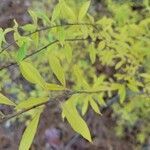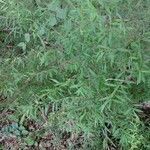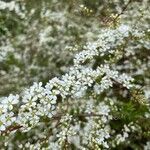Shrubs, 10–20 dm. Stems spreading to arching, densely branched. Leaves ?sometimes tardily deciduous?; petiole 1–2 mm or indistinct; blade linear to lanceolate, 2.5–4 × 0.3–1 cm, membranous, base acute, margins irregularly, sharply serrulate, venation pinnate eucamptodromous, secondary veins not prominent, apex acuminate, surfaces glabrous. Inflorescences mostly axillary, hemispheric panicles, ?(2–)3–7-flowered, sessile on leafless stems in spring?, 2–6 × 2–6 cm; branches glabrous. Pedicels 5–8 mm, glabrous. Flowers 6–8 mm diam.; hypanthia crateriform, 2–4 mm, abaxial surface glabrous, adaxial glabrous or puberulent; sepals ovate-triangular, 1.3–2 mm; petals white, obovate to suborbiculate, 2–4 mm; staminodes 10–14; stamens 18–20, 0.3 times petal length. Follicles oblanceoloid, 1.5–2 mm, glabrous. 2n = 18.





